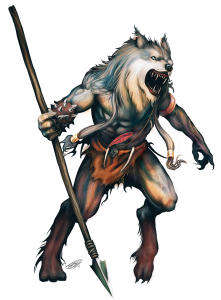
It’s Midgard Monday! Each week, we visit a corner of the wide world of Midgard. Look for standalone content you can drop into your campaign—whether it’s in Midgard or your own homebrew. Find new inspiration each Midgard Monday!
Parents tell their children horrific stories about werewolves snatching away the unwary and feasting on their bones, but werewolves largely keep to the far corners of Midgard, perhaps due to their terrifying reputation.
Indeed, to learn more about the shapeshifters, I, Casimir, traveled to the Northlands, where I braved the elements and risked having my throat ripped out. Unlike with other monsters I have chronicled, I relied primarily on third-party information, but I had the good fortune to interview two werewolves who have successfully integrated with society. However, they wish to remain anonymous, and I shall respect those wishes.
Get into Midgard with the Midgard Worldbook! This acclaimed campaign setting is rich and deep, with a decade of support from Kobold Press.
Want a more focused start? Try the Zobeck Clockwork City Collector’s Edition! This detailed sourcebook
gives players plenty of room to run, and includes adventures within the Clockwork City itself!
Feared and Distrusted
Werewolves inherently combine the wolf’s keen senses and skill at stalking prey with humanity’s propensity for malice. Though some resist the urge to give in to their “bestial natures”, most werewolves enjoy the freedom from society’s shackles and embrace the beasts inside, little realizing they have given in to their base human compulsions.
Most tales about werewolves describe them as ravening beasts that slaughter all they meet, which describes nearly every encounter with the lycanthropes. Owing to their own ferocity and further embellishments in horrifying accounts, civilizations killed the monsters or drove them out of their midst.
Typically unable to rein themselves to blend in with society like their wererat cousins, werewolves have migrated to Midgard’s less hospitable places. For most, the Northlands suits their needs, with ample game for hunting and a supernal acclimation to the cold conditions. Others moved to the Wasted West but have found existence more difficult because of the lack of edible food and potable water, as well as mutated monstrosities they can’t overpower or intimidate.
A few find work at the fringes of society as guards and soldiers where they partially control their primal urges and restrict their killing to intruders and enemy combatants. Their fearsome reputation drives some nations and armies to claim they employ werewolves to intimidate rivals and opponents.
The scant few civilized werewolves keep their true identities secret and employ magic to thwart divinations that could betray their identities. These werewolves often partake in activities enabling them to let loose solitarily, and they turn their attentions to obviously evil or despotic threats. Even then, they disguise their handiwork as mundane animal attacks.
Competitive Packmates
Among the wilder werewolves, hierarchy resolves simply: the strongest and toughest leads, and the younger and weaker follow or perish.
Disrespecting a more powerful werewolf results in the injury, maiming, or death of the offender. Despite their inherent need to assert dominance, werewolves in a family unit, whether through the spread of lycanthropy or as true children of lycanthropes, often work together to ensure their mutual survival. Deference may apply to true lycanthropes over those who acquired the curse of lycanthropy, but this provides no protection for a true lycanthrope who displays any vulnerability. Challenges for authority conclude with the death of the challenger or the challenged werewolf, so pack-bound werewolves show enough restraint to make their leadership claims outside of life-threatening circumstances.
Werewolves don’t extend this deference outside their own packs, however, and gleefully destroy nearby packs that show signs of weakness. This harmful viewpoint prevents werewolves from expanding beyond their modest holdings.
Destructive Urges
The werewolves’ bleak outlook makes them prime targets for cults and entities desiring to remake the world violently. Fenris has gathered considerable numbers of werewolves to his side to the point where the lycanthropes m set aside their lethal differences to fulfill the god’s needs.
The Vagrike, a nation devoted to the worship of Fenris, stands as a brutal monument to their cooperation, but factions of fey, dwarves, and Trylleri keep the nation in check. Also notably, the Vagrike has a proportionately small werewolf population relative to the total population, speaking further to their inability to coexist in large numbers. Furthermore, any weakness shown by Fenris or the current leader, Wargaz the Cruel, will result in the nation’s downfall as the werewolves fragment into smaller packs and jockey to gain control of the Vagrike.
Cults devoted to Boreas and Loki also attract werewolves who revel in the devastation wrought by the cults. Indeed, these werewolves seem to welcome the end of the world or their own deaths in pursuit of an oncoming apocalypse. This speaks to their twin desires to fight while they have breath and to escape a world that loathes them and requires them to fight constantly for survival. Provided the cult leaders demonstrate a strong and continued embrace for their plans for annihilation, werewolves will follow non-lycanthrope leaders.
Lone lycanthropes, whether “orphaned” by losing their packmates in battle or by escaping certain death at the fangs of their packmates, find it nearly impossible to integrate into new packs, since their status marks them as unworthy or cowards. Those unable to find cults to welcome them occasionally make their own packs by inflicting lycanthropy on others or go out in a frenzy of blood and gore.
Surprising Silver Stockpiles
Because werewolf packs conflict with each other over resources, petty grievances, and territorial dominance, they seek any advantage they can use against other werewolves. This even applies to temporary allies who help destroy rival packs, though these allies should realize the werewolves will turn on them after their triumph.
Silver, anathema to all lycanthropes, makes the most powerful weapon. Werewolves have learned they can procure it from adventuring parties questing to destroy them. The werewolves’ weakest packmates earn their continued existence by posing as “victims” preyed upon by the lycanthropes and luring adventurers armed with silver to their homes. The werewolves then store the plundered silver in a secure or hidden location so they can then use it against other packs. In cases where werewolf hunters sneak into werewolf dens, they prioritize finding these caches.
New Spell: Detect Shapechanger
Though most werewolves give themselves away eventually, this spell comes in handy for those attempting to hide their appearance as they bide their time to strike. It also helps locate subtler lycanthropes as well as pesky doppelgangers and mimics (all subjects for later entries).
DETECT SHAPECHANGER
1st-Circle Arcane, Divine, and Primordial (Divination)
Casting Time: 1 action
Range: Self
Components: V, S, M (silver dust worth at least 1 gp)
Duration: Concentration, up to 10 minutes
You sense nearby creatures who hide their true appearances.
You blow the silver dust high into the air. For the duration, you know if there is a creature with the Shapechanger tag within 30 feet of you and where the creature is located, as bits of silver dust cling to the creature and glow.
The spell can penetrate most barriers, provided the barrier has space for the dust to permeate.
Did you miss Free RPG Day? We’re running our Free RPG Day adventure in our Discord channel until the end of the month! Play Shards of the Spellforge online!



Thanks for the regular Midgard content!